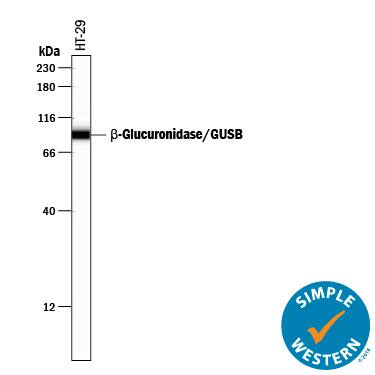Human beta-Glucuronidase/GUSB Antibody
R&D Systems, part of Bio-Techne | Catalog # AF6144

Key Product Details
Species Reactivity
Validated:
Cited:
Applications
Validated:
Cited:
Label
Antibody Source
Product Specifications
Immunogen
Met1-Thr651
Accession # AAA52561
Specificity
Clonality
Host
Isotype
Scientific Data Images for Human beta-Glucuronidase/GUSB Antibody
Detection of Human beta‑Glucuronidase/GUSB by Western Blot.
Western blot shows lysates of HT-29 human colon adenocarcinoma cell line. PVDF Membrane was probed with 1 µg/mL of Human beta-Glucuronidase/GUSB Antigen Affinity-purified Polyclonal Antibody (Catalog # AF6144) followed by HRP-conjugated Anti-Sheep IgG Secondary Antibody (Catalog # HAF016). A specific band was detected for beta-Glucuronidase/GUSB at approximately 82 kDa (as indicated). This experiment was conducted under reducing conditions and using Immunoblot Buffer Group 8.Detection of Human beta‑Glucuronidase/GUSB by Simple WesternTM.
Simple Western lane view shows lysates of HT-29 human colon adenocarcinoma cell line, loaded at 0.2 mg/mL. A specific band was detected for beta-Glucuronidase/GUSB at approximately 92 kDa (as indicated) using 10 µg/mL of Sheep Anti-Human beta-Glucuronidase/GUSB Antigen Affinity-purified Polyclonal Antibody (Catalog # AF6144) followed by 1:50 dilution of HRP-conjugated Anti-Sheep IgG Secondary Antibody (Catalog # HAF016). This experiment was conducted under reducing conditions and using the 12-230 kDa separation system.Applications for Human beta-Glucuronidase/GUSB Antibody
Simple Western
Sample: HT‑29 human colon adenocarcinoma cell line
Western Blot
Sample: HT‑29 human colon adenocarcinoma cell line
Formulation, Preparation, and Storage
Purification
Reconstitution
Formulation
Shipping
Stability & Storage
- 12 months from date of receipt, -20 to -70 °C as supplied.
- 1 month, 2 to 8 °C under sterile conditions after reconstitution.
- 6 months, -20 to -70 °C under sterile conditions after reconstitution.
Background: beta-Glucuronidase/GUSB
Human beta-Glucuronidase (EC 3.2.1.31) encoded by the GUSB gene is a lysosomal hydrolase involved in the stepwise degradation of glucuronic acid-containing glycosaminoglycans that include heparan sulfate, chondroitin sulfate and hyaluronan (1). The enzyme is only active on the glucuronic acid of the non-reducing end. The native protein has been reported as a tetrameric glycoprotein composed of identical subunits (1, 2). Mutations in the GUSB gene are linked to mucopolysaccharidosis type VII (3). Accumulation of partially degraded glycosaminoglycans, with glucuronic acid residues at the non-reducing termini, are usually found in the lysosomes of patients with the disease (3). It has also been reported that this enzyme may contribute to the depletion of chondroitin from cartilage and thereby facilitate the damage of joints in rheumatoid arthritis (4).
References
- Shipley, J.M. et al. (1993) Am. J. Hum. Genet. 52:517.
- Oshima, A, et al. (1987) Proc. Natl. Acad. Sci. USA 84:685.
- Bell, C.E. Jr. et al. (1977) J. Clin. Invest. 59:97.
- Ortutay, Z. et al. (2003) Arthritis Rheum. 48:2163.
Alternate Names
Entrez Gene IDs
Gene Symbol
UniProt
Additional beta-Glucuronidase/GUSB Products
Product Documents for Human beta-Glucuronidase/GUSB Antibody
Product Specific Notices for Human beta-Glucuronidase/GUSB Antibody
For research use only

